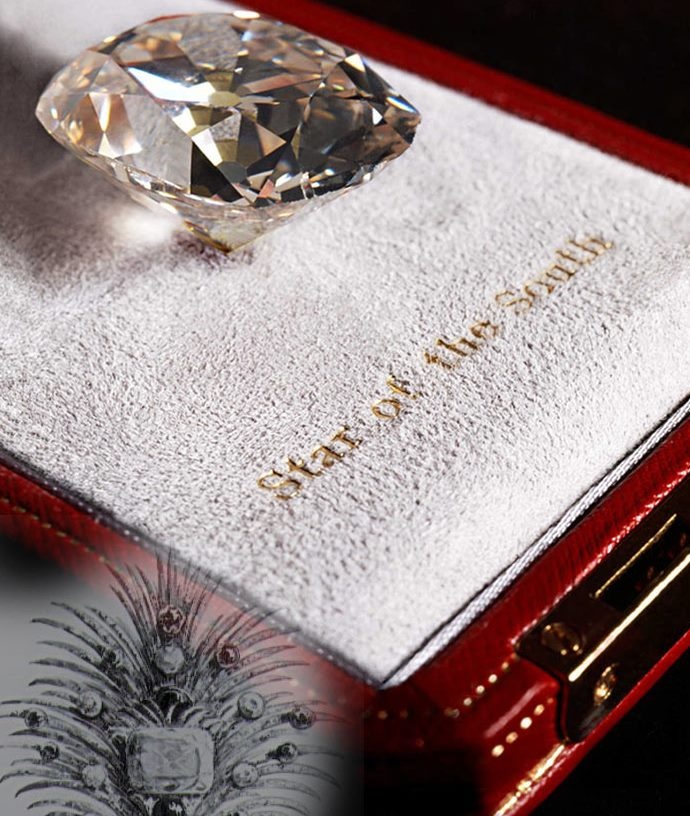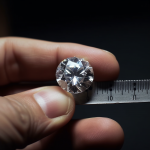Diamond Prices
Read moreThe Star of the South Diamond
The First Brazilian Diamond To Receive International Acclaim
The Star of the South Diamond, weighing 254.5 carats rough, is one of the biggest diamonds ever unearthed by a female. Its discoverer was a slave woman, who found it in 1853 in a river near the small town of Badagem in Minas Gerais, Brazil. The gem coursed through many continents and achieved worldwide fame at international expositions. It was cut by the same man who worked on the Koh-i-Noor into an oval cushion diamond, 128.48 carats in weight. The polished gemstone attracted the attention of royalty worldwide and spent decades in the royal family of Gaekwad. Continue reading to find out more about one of the largest & famous diamonds that has ever been found in Brazil.
In this article you will find:

- Discovered in
- 1853
- Country of Origin
- Brazil
- Mine of Origin
- Near the town of Bagagem, Minas Gerais
- Carat Weight
- Rough: 254.5 carats
- Cut: 128.48 carats (after cutting)
- Cut Shape
- Elongated cushion-shaped
- Clarity
- VS2 (Very Slightly Included 2)
- Color
- Fancy light pinkish-brown
- Previous Owners
- Casimiro de Tal (Master of the slave who found the diamond)
- Halphen Brothers (Diamond dealers in Paris)
- Royal Coster Diamond Company (Responsible for cutting)
- Gaekwad of Baroda (Indian Maharaja)
- Maharani of Baroda, Sita Devi
- Current whereabouts unknown, possibly owned by Rustomjee Jamsetjee or Cursetjee Fardoonji, and later rumored to be sold to Cartier in 2002
- Current Owner
- Unknown (possibly Cartier, but uncertain)
- Estimated Value
- Unknown
The Origins of the Star of the South diamond
The Star of the South was found by a Brazillian slave woman
The Star of the South diamond was found by an unnamed Brazillian slave woman near the Brazillian diamond-mining town of Badagem in 1853. She handed the diamond to her master, Casimiro de Tal, who greatly rewarded her for her honesty. For her deed, she was granted her freedom, new clothes, and the right to work for a wage.
During the 19th century, there were a set of laws that “encouraged” slave workers to be honest with all the comings and goings happening on their respective property. If these rules were followed, slaves were rewarded with freedom or material increments to their livelihood. For the purposes of our story, it is key to mention these laws most notably described punishment for the smuggling of diamonds. Modern estimates claim that about ⅓ of the diamonds found in Brazil were hidden and smuggled by slaves. Thus, the Star of the South Diamond owes its fame in large part due to the honesty of its finder.
The diamond quickly changed several owners
The master of the mining operation, Casimiro de Tal quickly found a buyer for the large 254.5-carat diamond. However, it seems that Casimiro was unaware of its real value, as he sold it for a mere £3000. In contrast, the anonymous buyer deposited the diamond in the bank of Rio de Janeiro and received an advance of £30,000 on its security alone. In 1855, it was sold in its rough state for £35,000 to the Halfen brothers. The Halfen brothers were diamond dealers in Paris. They named the gemstone ‘ ‘Étoile du Sud’ or ‘The Star of the South and in 1855 they exhibited the gemstone at the Paris Industrial Exhibition.
The cutting of the Star of the South diamond
The Royal Coster Diamond Company was commissioned for cutting the diamond
Either in 1856 or 1857, the Halphen brothers sent the Star of the South diamond to be cut in Amsterdam. Ultimately, the task would be undertaken by none other than the internationally recognized Royal Coster Diamond Company. The master polisher who would take on the ordeal was Mr. Voorzanger, who had previously worked on the recutting of the famous Koh-I-Noor, just one or two years earlier.
Various reports claim the cutting took 3 months and cost £2500. The result was a magnificent 128,48-carat elongated cushion-shaped diamond of great clarity. Its measurements were 35 mm long, 29 mm wide, and 19 mm thick. The cushioned shape of the diamond gave it a distinct pink-brown tint and although the cutting reduced half of the diamond’s weight, the owners were amazed by the result.
The Ownership History of the Star of the South diamond
The Star of the South Diamond gained fame at international exhibitions
After being cut by the Coster company in Amsterdam, the diamond was returned to the Halfen brothers & associates company. The Halfen syndicate displayed the gemstone in the 1862 London exhibition, as well as in the 1867 Paris exhibition. On both occasions, the diamond’s beauty gathered significant crowds and attention. Certainly, the press was attracted to the diamond’s allure, and the media’s coverage given to the stone contributed to the worldwide fame it enjoys today.
The Star of the South Diamond attracted the attention of international royalty
During the late 1860s, The Halfen brothers sent the diamond to India for examinations. It is known that an anonymous Indian Maharaja offered to buy the diamond for £100,000 at the time. Yet, the deal failed to materialize; the Halfen syndicate recalled the diamond to Paris, but the diamond’s trip was not in vain.
After such an explosive rise to fame, the diamond had gathered the attention of various Indian royalty members, who had proven to be keen diamond collectors. One such collector was the Gaekwad of Baroda, Khande Rao, who has since gone down in history as one of the biggest jewelry collectors. To provide context, it is rumored that he was the one who acquired the diamond collection of Josephine, the Empress of Napoleon III.
The Diamond became an Indian Royal Jewel
The Gaekwad instructed the famous 19th-century jeweler E.H. Dresden of London to purchase the diamond on his behalf. The sovereign recruited him to buy the Star of the South from the Halfer syndicate for the sum of eight lakhs of rupees, equal to £80,000. We can intuit that Mr. Dresden was a highly persuasive negotiator, as he managed to convince the syndicate to sell the diamond for a price of £20,000 lower than expected. The syndicate agreed and the stone was sold.
In 1880, Khande Rao, the Gaekwad of Baroda, had the Star of the South gemstone set into a necklace. The same necklace also featured the 78.5-carat English Dresden Diamond. Later on, more diamonds were added to the necklace. In 1948, the Maharani of Baroda, Sita Devi, was seen posing with the modified necklace. The occasion was her spouse’s, Maharajah Pratāp Sinh, birthday party.
The current whereabouts of the diamond are unknown
It is not known where the diamond actually is at this point, however, it is speculated that it has been in circulation for approximately 50 years. Various sources seem to indicate that the stone was acquired by Rustomjee Jamsetjee of Bombay. Others have cited the name Cursetjee Fardoonji of Bombay as a potential owner. Moreover, it is widely believed the relatives of the deceased Sita Devi sold the gemstone to Cartier in 2002. Today it is unclear whether the luxury jewelry brand Cartier still holds the Star of the South Diamond. Even though the whereabouts of the gem are unknown, its fame is still very much alive.
The technical characteristics of the Star of the South Diamond
The Star of the South Diamond is a pinkish-brown cushion-shaped diamond
The diamond weighed 254.5 metric carats or 50.9 grams in its rough state. The French mineralogist A. Dufrénoy (1856) describes the gem as “…a rhombic dodecahedron, bearing along each of its faces a curved junction [where adjoining faces meet] so that it became a solid of 24 faces.
After its cutting, the gem became a 124.48-carat (25.696g), cushion-shaped diamond. The stone measured 35 mm in length, 29 mm in width, and 13mm in thickness. The GIA has been able to certify it with a clarity of VS2 or very slightly included 2. This grade means that the inclusions are not visible to the naked eye.
The color grade is a fancy light-pinkish brown, which is one of the most sought-after colors for diamonds. The color appears naturally due to the gemstone’s cushion shape. The light that the gem reflects is perfectly white. However, the light that it refracts is soft rose pink which gives the diamond its highly regarded special pink-brown hue.
The Star of the South Diamond is a type IIa diamond, which means there are no measurable traces of nitrogen or boron impurities. Only 5% of diamonds are type IIa.
The Significance of the Star of the South Diamond
The Star of the South Diamond holds a rightful place among the most beautiful large diamonds in history. After its discovery, it became the largest diamond ever found by a woman, for the next 100 years. At the time of its cutting it was the 6th largest gem in the world, and today it is still the 23rd largest cut gem. It is a true pioneer of the largest Brazillian diamonds to achieve international fame. It became so famous that the place where it was discovered, the city of Bagagem, was renamed after the diamond. The city now holds the name Estrela do Sul.
We hope you enjoyed the read!
If you’d like to read about other famous diamonds like the Orlov, Eureka, or Premier Rose diamonds, you can visit Ajediam’s Famous Diamonds glossary. Or, if you’re feeling inspired, you can browse Ajediam’s premium diamond collections shop.



